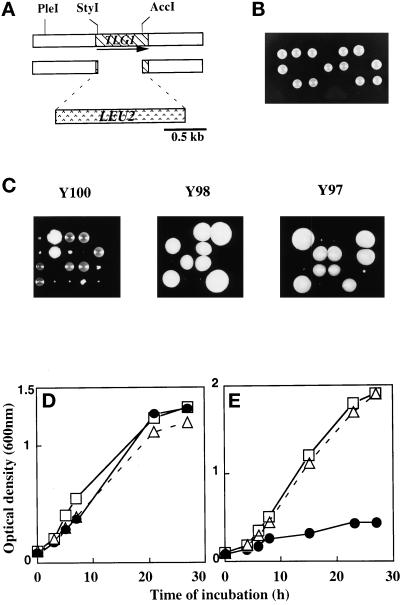Figure 1.
TLG1 is essential for cell growth. (A) Disruption strategy to create a null mutation of TLG1 in the yeast genome. The arrow represents the direction of transcription. (B) Dissection result of heterozygous W303 yeast diploids containing Δtlg1::LEU2. Correct integrants verified by Southern blotting were incubated on a sporulation plate for 3 d at 30°C. Asci were glusulase treated, and tetrads were segregated on a dissection microscope. Surviving progeny were wild-type for TLG1. (C) Dissection of Y100 (SEY6210 × SEY6211)-, Y98 (MATa/α ade2-1, ade3Δ his3-11,-15 leu2-3,-112 trp1-Δ1 ura3-1 can1-100)-, and Y97 (RSY255 × SEY6210)-based asci in which two of the spores from each tetrad contain Δtlg1::LEU2. The middle and right panels of C were dissection plates incubated at 30°C for 5 d. All other plates were incubated for 3 d at 30°C. Δtlg1 cells grew poorly, as revealed by the tiny colonies, particularly in Y97 and Y98 cells. (D) Reintroduction of an episomal TLG1 under the control of an inducible GAL1 promoter in Δtlg1::LEU2 cells from W303 background restores cell growth in galactose-based media but not in glucose-based media. The growth curves of wild type (open squares), a heterozygous diploid of Δtlg1::LEU2 (open triangles), and Δtlg1::LEU2 cells (closed circles) containing the wild-type TLG1 under the control of the GAL1 promoter (pYTLG1) are shown. Cells were grown in YEP-galactose (D) to induce or in YEP-glucose (E) liquid media to deplete the Tlg1p. Cell growth was measured by optical density at 600 nm at the indicated times.

